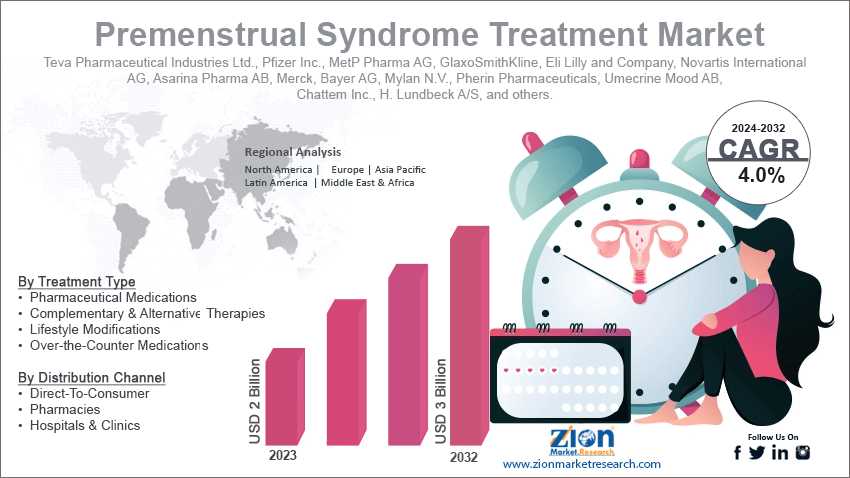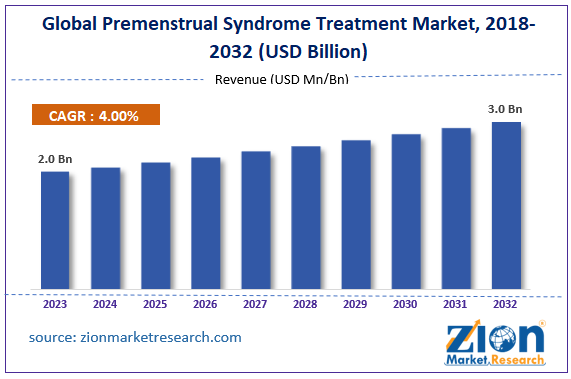Premenstrual Syndrome Treatment Market Size, Share, Trends, Growth and Forecast 2032

Premenstrual Syndrome Treatment Market By Treatment Type (Pharmaceutical Medications, Complementary & Alternative Therapies, Lifestyle Modifications, and Over-the-Counter Medications), By Distribution Channel (Direct-To-Consumer, Pharmacies, and Hospitals & Clinics), and By Region - Global and Regional Industry Overview, Market Intelligence, Comprehensive Analysis, Historical Data, and Forecasts 2024 - 2032
| Market Size in 2023 | Market Forecast in 2032 | CAGR (in %) | Base Year |
|---|---|---|---|
| USD 2 Billion | USD 3 Billion | 4% | 2023 |
Premenstrual Syndrome Treatment Industry Prospective:
The global premenstrual syndrome treatment market size was evaluated at $2 billion in 2023 and is slated to hit $3 billion by the end of 2032 with a CAGR of nearly 4% between 2024 and 2032.
Premenstrual Syndrome Treatment Market: Overview
Premenstrual syndrome is a common condition causing physical, behavioral, and emotional changes occurring in the luteal phase of the menstrual cycle. Symptoms can differ from woman to woman and treatment can vary based upon the symptoms. A few of the common treatments for premenstrual syndrome include lifestyle changes, over-the-counter medications, hormonal treatments, prescribed medicines, and alternative treatments. Making lifestyle changes, such as doing physical exercise and intake of nutritious diet, are some of the effective treatments for premenstrual syndrome in women.
Key Insights
- As per the analysis shared by our research analyst, the global premenstrual syndrome treatment market is projected to expand annually at the annual growth rate of around 4% over the forecast timespan (2024-2032)
- In terms of revenue, the global premenstrual syndrome treatment market size was evaluated at nearly $2 billion in 2023 and is expected to reach $3 billion by 2032.
- The global premenstrual syndrome treatment market is anticipated to grow rapidly over the forecast timeline owing to surging awareness about premenstrual syndrome and the drafting of government programs creating awareness about the same.
- In terms of treatment type, the lifestyle modifications segment is slated to dominate the segmental space over the forecast period.
- Based on distribution channel, the pharmacies segment is predicted to lead the global industry surge in the ensuing years.
- Region-wise, the Asia-Pacific premenstrual syndrome treatment industry is projected to register the fastest CAGR during the assessment timespan.
Premenstrual Syndrome Treatment Market: Growth Factors
Escalating incidences of premenstrual syndrome across the globe to embellish the growth of the market globally
Rising occurrence of premenstrual syndrome in women is likely to boost the growth of the global premenstrual syndrome treatment market. Surging awareness about premenstrual syndrome and drafting government programs creating awareness about the same will drive the global market trends.
Huge focus on improving women’s health and breakthroughs in medical treatments such as hormone therapies, analgesics, and anti-depressants will steer the global market expansion. Aging population prone to the disease will augment the global market trends.
Premenstrual Syndrome Treatment Market: Restraints
Lesser knowhow among the female population about premenstrual syndrome to constrict the global industry surge
Lack of awareness among women about premenstrual syndrome symptoms can severely impact the expansion of the global premenstrual syndrome treatment industry. Furthermore, lesser treatment alternative availability can impact the growth rate of the global industry. Adverse effects of current treatment can degrade the global industry upsurge in the years ahead.
Premenstrual Syndrome Treatment Market: Opportunities
Surging patient inclination towards non-pharmacological therapies to craft panoramas of opportunities for the global market
Breakthroughs in pharmacological treatments and a rise in research activities are expected to open new growth avenues for the global premenstrual syndrome treatment market. Furthermore, growing patient preference for non-pharmacological treatment, such as intake of healthy food and adoption of cognitive behavioral therapy, will spearhead the global market surge in the years ahead.
Premenstrual Syndrome Treatment Market: Challenges
Rising healthcare costs & inadequate compensation policies can challenge the global industry progress
Surging healthcare prices and less insurance coverage can retard access to premenstrual syndrome treatment, thereby challenging the growth of the global premenstrual syndrome treatment industry. Cultural stigmas pertaining to menstruation can decline the growth of the industry across the globe.
 Request Free Sample
Request Free Sample
Premenstrual Syndrome Treatment Market: Report Scope
| Report Attributes | Report Details |
|---|---|
| Report Name | Premenstrual Syndrome Treatment Market |
| Market Size in 2023 | USD 2 Billion |
| Market Forecast in 2032 | USD 3 Billion |
| Growth Rate | CAGR of 4% |
| Number of Pages | 221 |
| Key Companies Covered | Teva Pharmaceutical Industries Ltd., Pfizer Inc., MetP Pharma AG, GlaxoSmithKline, Eli Lilly and Company, Novartis International AG, Asarina Pharma AB, Merck, Bayer AG, Mylan N.V., Pherin Pharmaceuticals, Umecrine Mood AB, Chattem Inc., H. Lundbeck A/S, and others. |
| Segments Covered | By Treatment Type, By Distribution Channel, and By Region |
| Regions Covered | North America, Europe, Asia Pacific (APAC), Latin America, Middle East, and Africa (MEA) |
| Base Year | 2023 |
| Historical Year | 2018 to 2022 |
| Forecast Year | 2024 - 2032 |
| Customization Scope | Avail customized purchase options to meet your exact research needs. Request For Customization |
Premenstrual Syndrome Treatment Market: Segmentation
The global premenstrual syndrome treatment market is divided into treatment type, distribution channel, and region.
In terms of treatment type, the premenstrual syndrome treatment market across the globe is segmented into pharmaceutical medications, complementary & alternative therapies, lifestyle modifications, and over-the-counter medications segments. The lifestyle modifications segment is likely to be the dominating segment during the forecast timeline owing to its low cost, non-invasive features, and minimum side effects.
On the basis of distribution channel, the global premenstrual syndrome treatment industry is bifurcated into direct-to-consumer, pharmacies, and hospitals & clinics segments. Furthermore, the pharmacies segment is predicted to lead the growth of the global industry in the coming eight years. The key growth drivers of the segment are easy access to medicines, guidance, and counseling to patients in pharmacies. Moreover, easy access to medicines in pharmacies is due to the availability of a strong distribution network of pharmacies.
Premenstrual Syndrome Treatment Market: Regional Insights
North America is projected to maintain a leading position in the global market over the analysis timeline
North America, which accounted for approximately 52% of the global premenstrual syndrome treatment market revenue in 2023, is expected to maintain number one status in the period from 2024 to 2032. Apparently, a burgeoning growth of the market in North America over the forecast period can be due to the rising occurrence of premenstrual syndrome in North American women along with the presence of key players in countries such as the U.S.
Apart from this, the presence of advanced healthcare amenities in the region will enhance the revenue growth of the market in North America. The region has giant players in biopharmaceutical and biomedical research, thereby driving the innovation in premenstrual syndrome treatment, and thereby creating lucrative growth opportunities for the market in the North American region.
Asia-Pacific premenstrual syndrome treatment industry is set to record the highest CAGR in the forecast period. The industry expansion in APAC can be attributed to the surging women population in countries such as India, Bangladesh, Pakistan, and China. Demand for advanced healthcare services and an increase in the per capita income in Asia will propel the expansion of the industry in APAC.
Premenstrual Syndrome Treatment Market: Competitive Space
The global premenstrual syndrome treatment market profiles key players such as:
- Teva Pharmaceutical Industries Ltd.
- Pfizer Inc.
- MetP Pharma AG
- GlaxoSmithKline
- Eli Lilly and Company
- Novartis International AG
- Asarina Pharma AB
- Merck
- Bayer AG
- Mylan N.V.
- Pherin Pharmaceuticals
- Umecrine Mood AB
- Chattem Inc.
- H. Lundbeck A/S
The global premenstrual syndrome treatment market is segmented as follows:
By Treatment Type
- Pharmaceutical Medications
- Complementary & Alternative Therapies
- Lifestyle Modifications
- Over-the-Counter Medications
By Distribution Channel
- Direct-To-Consumer
- Pharmacies
- Hospitals & Clinics
By Region
- North America
- The U.S.
- Canada
- Europe
- France
- The UK
- Spain
- Germany
- Italy
- Rest of Europe
- Asia Pacific
- China
- Japan
- India
- South Korea
- Southeast Asia
- Rest of Asia Pacific
- Latin America
- Brazil
- Mexico
- Rest of Latin America
- Middle East & Africa
- GCC
- South Africa
- Rest of Middle East & Africa
Table Of Content
Methodology
FrequentlyAsked Questions
Premenstrual syndrome is a common condition causing physical, behavioral, and emotional changes occurring in the luteal phase of the menstrual cycle. Symptoms can differ from woman to woman and treatment can vary based upon the symptoms.
The global premenstrual syndrome treatment market growth over the forecast period can be owing to a huge focus on improving women’s health and breakthroughs in medical treatments such as hormone therapies, analgesics, and anti-depressants.
According to a study, the global premenstrual syndrome treatment industry size was $2 billion in 2023 and is projected to reach $3 billion by the end of 2032.
The global premenstrual syndrome treatment market is anticipated to record a CAGR of nearly 4% from 2024 to 2032.
The Asia-Pacific premenstrual syndrome treatment industry is set to register the fastest CAGR over the forecasting timeframe owing to the surging women population in countries such as India, Bangladesh, Pakistan, and China. Demand for advanced healthcare services and an increase in the per capita income in Asia will propel the expansion of the industry in APAC.
The global premenstrual syndrome treatment market is led by players such as Teva Pharmaceutical Industries Ltd., Pfizer Inc., MetP Pharma AG, GlaxoSmithKline, Eli Lilly and Company, Novartis International AG, Asarina Pharma AB, Merck, Bayer AG, Mylan N.V., Pherin Pharmaceuticals, Umecrine Mood AB, Chattem Inc., and H. Lundbeck A/S.
The global premenstrual syndrome treatment market report covers the geographical market along with a comprehensive competitive landscape analysis. It also includes cash flow analysis, profit ratio analysis, market basket analysis, cash-benefit analysis, market attractiveness analysis, sentiment analysis, PESTEL analysis, trend analysis, SWOT analysis, trade area analysis, demand & supply analysis, Porter’s five force analysis, factor analysis, and value chain analysis. It provides an apt scenario about demand and factor conditions in the country impacting the profitability of the firms in the domestic and international markets.
HappyClients
Zion Market Research
Tel: +1 (302) 444-0166
USA/Canada Toll Free No.+1 (855) 465-4651
3rd Floor,
Mrunal Paradise, Opp Maharaja Hotel,
Pimple Gurav, Pune 411061,
Maharashtra, India
Phone No +91 7768 006 007, +91 7768 006 008
US OFFICE NO +1 (302) 444-0166
US/CAN TOLL FREE +1 (855) 465-4651
Email: sales@zionmarketresearch.com
We have secured system to process your transaction.
Our support available to help you 24 hours a day, five days a week.
Monday - Friday: 9AM - 6PM
Saturday - Sunday: Closed






